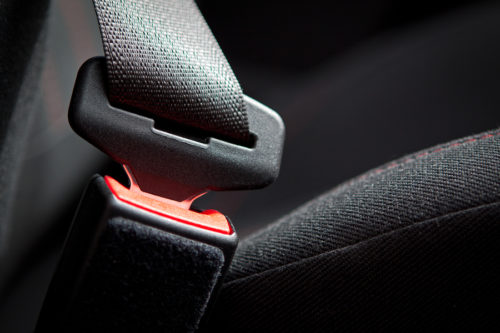Automobile technology has made astounding advances in the little more than a century since cars first began replacing the horse-and-buggy. Among the most significant of those are improvements in automotive safety. Seat belts, airbags, car body design, and modern materials have made cars and trucks far safer over time, saving millions of lives.
However, advances in safety technology have not come without problems. Some safety features of modern automobiles, ironically, cause injuries in crashes, even while preventing other, perhaps more serious ones. Airbags, for example, may save your life, but leave you with a concussion that could leave you permanently disabled.
In this blog post, we explore some of those injury-causing safety features and discuss how a car accident attorney can help if a motor vehicle collision injures you despite the protections they offer.
Airbags
The United States awarded the first airbag patent in 1953. It took another twenty years before airbags started to find their way into production automobiles. Today, airbags constitute a standard safety feature in virtually all passenger cars and trucks sold in the United States.
The purpose of airbags is to prevent a vehicle occupant’s head and torso from colliding with hard surfaces inside a vehicle in a crash. Driver-side airbags protect a driver’s head and body from slamming against the steering wheel. Passenger-side airbags prevent a collision with the dashboard. Both provide some measure of protection against unbelted passengers colliding with, and even breaking through, the windshield. Side-impact airbags protect all vehicle occupants from banging their heads against the vehicle frame.
Airbags deploy in around 0.016 seconds to prevent injury in a crash. Unfortunately, the rapid deployment of airbags can lead to a wide range of injuries even when airbags work as intended in a collision, including:
- Concussions and other traumatic brain injuries;
- Burns to face, hands, arms, and chest;
- Wrist injuries;
- Sprained fingers and wrists;
- Cuts to face;
- Whiplash;
- Fractures to the skull, rib cage, face, arms, and wrists;
- Eye injuries;
- Internal bleeding; and
- Hearing loss.
A stunning fact about these injuries is that they happen when an airbag works as intended. That is, even when an airbag saves your life, it can still hurt you. Badly.
Unfortunately, airbags have also been known to malfunction. For example, depending on the circumstances, a sudden, unexpected airbag deployment can have catastrophic consequences. In addition to causing the types of injuries listed above, an airbag that deploys spontaneously can catch a driver off-guard and lead to the loss of control of a vehicle and a dangerous, even deadly, crash.
In fact, airbags made by the manufacturer Takata, installed in numerous makes and models of vehicles across multiple manufacturers, have failed so often that they required widespread recalls. Injuries resulting from these failures—principally airbags that did not deploy when they should have, or that deployed spontaneously when they should not have—have also spurred numerous individual and class action lawsuits by injured drivers and passengers, and grieving families.
If a car accident caused you or a loved one harm, whether an airbag didn’t work as intended or someone caused a crash where an airbag helped to reduce the severity of your injuries, contact an experienced motor vehicle accident injury attorney right away. You may have substantial legal rights to compensation for your injuries and losses.
Seat Belts
We tend to take seat belts for granted. Today, over-the-shoulder seat belts for front and back passengers come standard in every new car sold in the United States. According to the Centers for Disease Control and Prevention (CDC), America’s public health agency, seat belts save tens of thousands of lives every year.
However, while seat belts can save your life, they can also leave you with serious injuries in a crash, including severe contusions, broken bones, and even internal organ damage when the force of a crash leads to them tightening too much across a vehicle occupant’s body. A pregnant woman may survive a crash because of a seat belt—but because of the seat belt, her unborn baby might not.
These injuries can happen even when people wear seat belts correctly.
Seat belts worn incorrectly may cause even more severe and catastrophic injuries, and even death.
Follow these tips from the National Highway Transportation Safety Administration (NHTSA) to ensure a proper seat belt fit, and to prevent seat belt-related injuries:
- Wear a shoulder harness across the shoulder and chest with minimal, if any slack. Never wear the shoulder belt under the arm or behind your back.
- Adjust the lap belt to make it snug and lying low across your hips. Never go without a lap belt.
- Sit upright with your back against the seat, and with your feet on the floor. Seat belts do not work as effectively if you do not sit upright in a safe position.
- Wear a seat belt even if your car or truck also has airbags. Airbags constitute a secondary mode of protection. They enhance the effectiveness of seat belts, but do not replace them.
- All children under the age of 12 must sit in the rear seat, must have appropriate child-safe seats or boosters, and wear appropriate seat belts for their height and weight.
Seat belt technology has existed for so long that it should constitute one of the most dependable safety features of any modern vehicle. Manufacturers have little excuse for selling any car or truck with seat belts that harm vehicle occupants in a collision. If a car accident left you or a loved one injured after a crash—regardless of whether a seat belt reduced or worsened your injuries—contact an experienced automotive injury lawyer today for a free consultation about your legal rights to compensation.
Driver Assistive Features
Today’s new cars come with some truly amazing features intended to supplement a driver’s own abilities to control a vehicle and to react to road hazards. Manufacturers give these features a variety of (sometimes confusing) names, such as brake assist or adaptive cruise control.
In general, they fall into two broad categories:
- Detection/warning systems. These features combine cameras and other sensors to see and warn a driver about potential hazards around the vehicle. They include systems to warn about pedestrians in front of or behind the vehicle, objects in the vehicle’s blind spot, unexpected departures from a lane, and changes in traffic speed or road conditions.
- Braking systems. These features apply the brakes automatically under a set of specified conditions. To some degree, they take over for the driver when the car senses a potential hazard and, sometimes, the driver’s own failure to react quickly enough to that hazard.
These systems can make significant contributions to vehicle safety. However, for now they also create two significant, unintended hazards.
- First, they often take unsuspecting drivers by surprise when they engage without warning. This can lead drivers to overcorrect or otherwise take extreme action in reaction to what they perceive as a loss of control, rather than a feature that improves control. As a result, a feature intended to prevent an accident can instead prompt driver behavior that causes one. (Incidentally, drivers are not alone in reacting this way to automatic safety systems. The airplane manufacturer Boeing suspended production of its 737-Max jetliner because a feature of the flight control software, intended to take over for the pilot in emergencies, instead led to several tragic crashes.)
- Second, drivers who are aware of these features have been known to put too much trust in them. No doubt inspired by popular science touting a rosy future of self-driving cars, drivers sometimes make the tragic mistake of thinking that the future has already arrived in the form of driver-assist features. Make no mistake, however: no production-model automobile for sale today can drive itself. Driver-assist features are NOT self-driving features. Not even partially. A driver cannot, and should not, rely on adaptive cruise control and lane departure assist features that sense changes direction and traffic patterns as a substitute for one’s keeping hands on the wheel, eyes on the road, and mind on the task of driving. For now, the future of completely autonomous self-driving cars lies far, far ahead.
If you or a loved one got into a crash precipitated, in one form or another, by a negligent driver who thought that automatic braking or warning systems meant to serve as a form of autopilot, speak with a skilled, knowledgeable motor vehicle accident injury attorney today. You may have important rights to receive significant financial compensation.
How Car Accident Lawyers Can Help
Car accident lawyers protect injured accident victims and the public at large by holding automotive manufacturers financially accountable when supposed vehicle safety features cause harm. 
If you sustained injuries in an accident and believe at least some of the harm you suffered occurred because of an airbag, seat belt, driver-assist system, or other safety feature, an experienced motor vehicle accident and product liability lawyer may help you recover the compensation you deserve by:
- Investigating the root causes and mechanisms of the accident and your injury. Lawyers with experience in complex automotive accident matters know where to find essential information that may prove the role a safety feature played in your accident, and how to analyze that information. Oftentimes, those lawyers work with trusted experts in the fields of accident reconstruction and automotive technology forensics to extract clues from on-board vehicle computers and from the damaged vehicle itself. The goal of this investigation is to pinpoint how a so-called safety feature contributed to a collision and/or your injuries, and to identify the individual or corporate parties who should bear legal responsibility for that harm.
- Negotiating with parties who have legal liability to you for your injuries in pursuit of a fair and reasonable financial settlement of your legal claims for damages. Most (but not all) motor vehicle accident claims settle through negotiations between the injured party (you) and the at-fault party (such as vehicle/part manufacturers and their insurance representatives). An experienced auto accident injury attorney has the negotiating skill to get you the most favorable settlement available, and also, the experience to know when to advise you to reject a settlement offer because it does not deliver the compensation you deserve.
- Litigating your crash injury claim in court, either as an individual lawsuit or as a class action on behalf of not just you, but all of the other vehicle occupants injured in the same manner. It takes a skilled, seasoned motor vehicle accident injury attorney to go up against auto manufacturers and their insurance companies and defense lawyers. Only trust your auto safety feature-related claim to a lawyer with years of experience fighting for the legal and financial rights of injured vehicle drivers and passengers like you.
No lawyer can guarantee the outcome of any crash injury claim, of course. Every case has its own unique facts and circumstances that influence its outcome. In general, however, a claim for damages resulting from the malfunction of a vehicle safety feature may recover damages to compensate you for your medical and other crash-related expenses, your lost wages, your future disability, and the pain, suffering, and diminished quality of life you and your family have been forced to endure because of a safety feature-related crash.
Contact a Trusted Car Accident Lawyer for More Information
Car accident injuries can alter your life forever. Even the mildest of traumatic brain injuries, for example, can require extensive and prolonged medical attention, and cost you tens of thousands of dollars out-of-pocket, even after medical insurance pays its share. Those expenses take a massive toll on their own, not to mention the physical and emotional struggle caused by an accident injury.
You do not deserve to bear the burden of those challenges on your own, especially not if they happened because a vehicle safety feature failed to do its job of keeping you safe from harm in a crash, or because another driver’s negligence was more than those safety features could handle.
Instead, you have the right to expect justice, accountability, and fair compensation for your difficulties from the automotive manufacturers and others whose shoddy products put you in harm’s way.
If a car accident wreaks havoc and devastation in your life, either by injuring you or a loved one, do not wait to seek quality legal help. You may have the right to recover a substantial amount of money for your troubles, but only if you act quickly to protect your interests. Contact an experienced, knowledgeable, and well-resourced motor vehicle accident attorney today for a free consultation.







